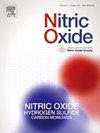Role of hydrogen sulfide-microRNA crosstalk in health and disease
IF 3.2
2区 生物学
Q2 BIOCHEMISTRY & MOLECULAR BIOLOGY
引用次数: 0
Abstract
The mutual regulation between hydrogen sulfide (H2S) and microRNA (miRNA) is involved in the development of many diseases, including cancer, cardiovascular disease, inflammatory disease, and high-risk pregnancy. Abnormal expressions of endogenous H2S-producing enzyme and miRNA in tissues and cells often indicate the occurrence of diseases, so the maintenance of their normal levels in the body can mitigate damages caused by various factors. Many studies have found that H2S can promote the migration, invasion, and proliferation of cancer cells by regulating the expression of miRNA, while many H2S donors can inhibit cancer progression by interfering with the proliferation, apoptosis, cell cycle, metastasis, and angiogenesis of cancer cells. Furthermore, the mutual regulation between H2S and miRNA can also prevent cell injury in cardiovascular disease and inflammatory disease through anti-inflammation, anti-oxidation, anti-apoptosis, and pro-autophagy. In addition, H2S can promote angiogenesis and relieve vasoconstriction by regulating the expression of miRNA, thereby improving fetal growth in high-risk pregnancy. In this review, we discuss the mechanism of mutual regulation between H2S and miRNA in various diseases, which may provide reliable therapeutic targets for these diseases.
硫化氢-微小核糖核酸串扰在健康和疾病中的作用
硫化氢(H2S)和微RNA(miRNA)之间的相互调控参与了许多疾病的发生,包括癌症、心血管疾病、炎症性疾病和高危妊娠。内源性 H2S 产酶和 miRNA 在组织和细胞中的异常表达往往预示着疾病的发生,因此维持它们在体内的正常水平可以减轻各种因素造成的损害。许多研究发现,H2S 可以通过调节 miRNA 的表达促进癌细胞的迁移、侵袭和增殖,而许多 H2S 供体则可以通过干扰癌细胞的增殖、凋亡、细胞周期、转移和血管生成来抑制癌症的发展。此外,H2S 和 miRNA 之间的相互调控还能通过抗炎、抗氧化、抗细胞凋亡和促自噬来防止心血管疾病和炎症性疾病中的细胞损伤。此外,H2S 还能通过调节 miRNA 的表达促进血管生成,缓解血管收缩,从而改善高危妊娠中胎儿的生长状况。在这篇综述中,我们探讨了 H2S 和 miRNA 在各种疾病中的相互调控机制,从而为这些疾病提供可靠的治疗靶点。
本文章由计算机程序翻译,如有差异,请以英文原文为准。
求助全文
约1分钟内获得全文
求助全文
来源期刊

Nitric oxide : biology and chemistry
生物-生化与分子生物学
CiteScore
7.50
自引率
7.70%
发文量
74
审稿时长
52 days
期刊介绍:
Nitric Oxide includes original research, methodology papers and reviews relating to nitric oxide and other gasotransmitters such as hydrogen sulfide and carbon monoxide. Special emphasis is placed on the biological chemistry, physiology, pharmacology, enzymology and pathological significance of these molecules in human health and disease. The journal also accepts manuscripts relating to plant and microbial studies involving these molecules.
 求助内容:
求助内容: 应助结果提醒方式:
应助结果提醒方式:


